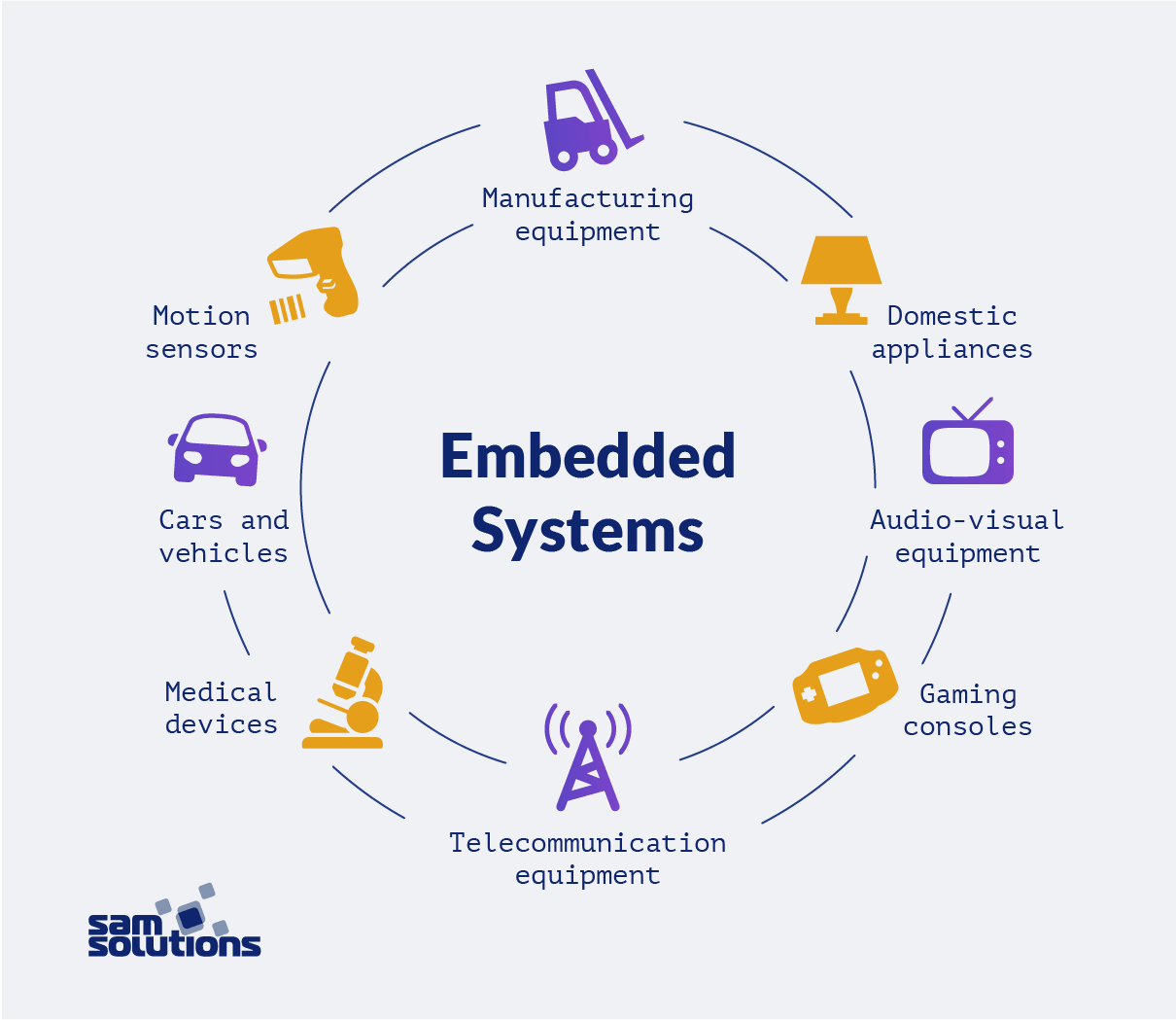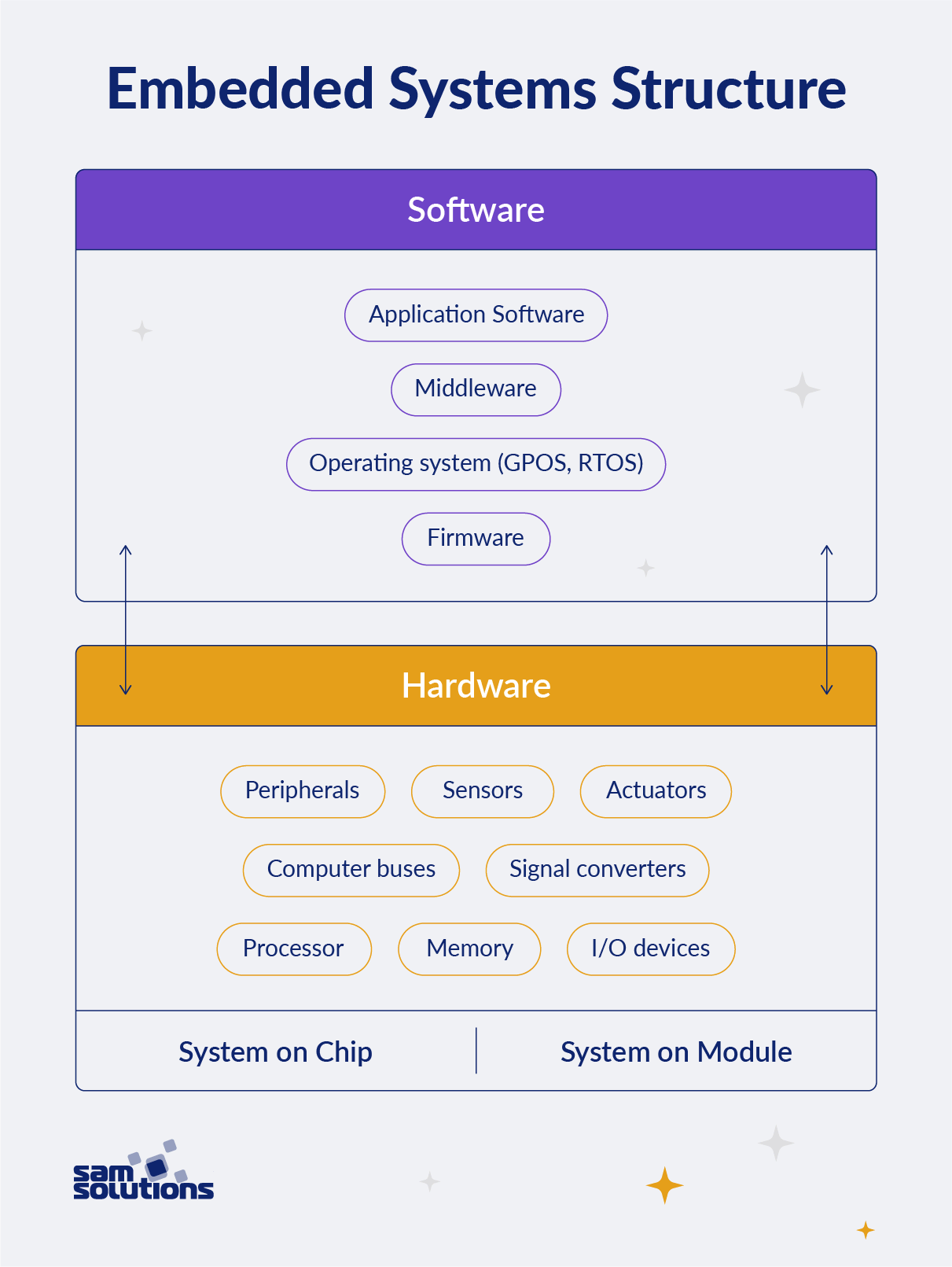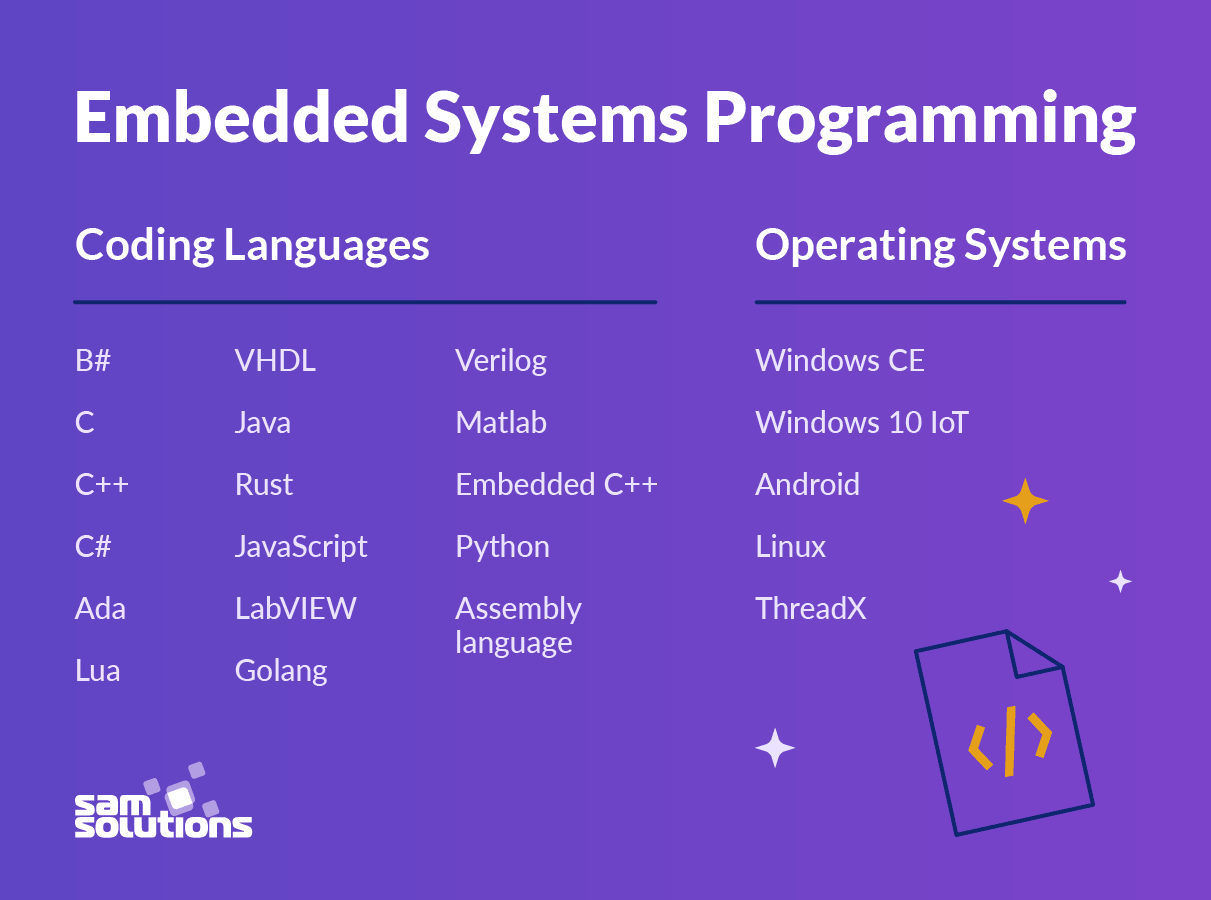SaM Solutions offers a complete range of end-to-end Embedded development services.
Our Embedded Programming Services offering
- End-to-End embedded development services
- Embedded Consulting and Audit
- Architecture Assessment
- Development of an embedded system for a larger software project
- Replatforming, optimization, performance tuning
- Research and Prototyping (PoC, MVP)
- Maintenance and support
- QA and testing
- APIs and integrations
- Linux device driver development
- Custom firmware development
- Internet of Things development
- Drivers and board support packages development
- AI/ML Development
- Cross-Platform Mobile App Development
Doing business with us means speaking the same language with like-minded professionals offering strong technical expertise, ingenuity and innovative approaches to solving your business problems.
If you would like to know more about our embedded software programming services, technologies, devices, client success stories, and tech partnerships, click the button below or contact us.
Choose SaM Solutions for your embedded and firmware development needs and take advantage of our extensive experience in the industry.
OVERVIEW
Living side by side with smart devices has become a convenient and comfortable practice for all of us. But what do we know about modern washing machines or coffee makers apart from which buttons to push? Not much. Their sophisticated performance remains invisible to ordinary users because hardly anyone looks inside these machines.
In today’s article, we are going to look under the hood and find out what’s responsible for the operation of embedded systems. Our big buzz topic is embedded software development and its undeniable influence on various domains
What Is an Embedded System?
While general-purpose computers traditionally perform a diversity of functions, have a screen and a keyboard, and connect to the internet, embedded systems work and may look entirely different.
An embedded system is a small or large non-computer device with integrated software based on microcontrollers and microprocessors for performing a dedicated function or a limited set of functions.
It may or may not have a screen and a keyboard, be either programmable or non-programmable, perform a single function in isolation, or work as a part of a large system.

A TV remote control, a microwave oven, a network of sensors and control systems in automobiles and complicated manufacturing robotic equipment — all these devices and electronic systems operate due to embedded software.
Common Features of Embedded Systems
- Designed to perform specific repeated functions on certain single-purpose devices
- Should perform their functions quickly, sometimes within a prescribed timeframe
- Based on microprocessors and microcontrollers
- May work without operating systems or use special OSs, quite often real-time operating systems (RTOS)
- Work with limited memory, power and computing resources
- May or may not have a keyboard, screen, user interface, connectivity
Embedded System Structure
Any embedded system, large or small, primitive or complicated, is always the integration of a hardware layer and a software layer. The scheme of an embedded system depicts common hardware and software elements.

Embedded Hardware
The hardware layer is built around a central processing unit (CPU) that serves as the main system controller. A CPU can be represented by:
- a microprocessor, which contains only a CPU and has minimal power to perform one simple operation
- a microcontroller, which is the integration of a CPU, I/O ports, RAM/ROM memory on one chip and can perform several tasks.
Other essential embedded hardware elements include:
- memory devices for data storage
- I/O devices for input and output operations
- computer buses for transferring data between hardware components
- sensors for converting physical data into analog electrical signals
- analog-to-digital converters (ADC) for transforming analog electrical signals (e.g. sound or light) into digital ones that the processor can read
- digital-to-analog converters (DAC) for transforming digital signals from the processor into electrical ones
- actuators for making mechanisms function based on the signal from the processor, for example, making a motor move
- peripherals (cameras, printers, scanners, keyboards, etc.).
Embedded hardware elements can be integrated on one board, comprising a system on chip (SoC). You can also use for your project a more complicated board — a system on module (SoM), which is the integration of many chips.
Embedded Software
The software layer may contain various components depending on the device’s complexity and purpose. A complete embedded software package includes four constituents:
- Firmware — a built-in program written for certain hardware.
- An operating system — software for setting rules and controlling system resources. It includes device drivers that provide API for upper software components and make them communicate with hardware parts. There are general-purpose and real-time operating systems (GPOS and RTOS).
- Middleware — a mediator that enables the communication between upper and lower software levels. Middleware is created for a definite operating system and lies between an OS and application software.
- Application software — software that directly performs the system’s functions and interacts with end users.
Large complicated embedded systems contain all of these components while simple embedded solutions may lack some software parts, for example, an operating system.
Types of Embedded Systems
There are several classifications of embedded systems depending on various attributes.
Categories of embedded systems based on functional requirements:
- Standalone — perform one or several simple tasks independently on other systems. Examples are an electronic thermometer and a digital alarm clock.
- Networked — need a wired or wireless network to share data with the server and other devices. Examples are smart home systems or self-service kiosks.
- Mobile — compact lightweight devices that you can easily take with you. They operate either independently or through the network. Examples are digital cameras or smartphones.
- Real–time — must perform tasks within determined time limits. Examples are life-saving medical equipment or military defense systems.
Categories of embedded systems based on the type of microcontrollers they use:
- Small–scale — use 8-bit or 16-bit microcontrollers. These are usually parts of larger systems.
- Medium–scale — use 16-bit or 32-bit microcontrollers. They have a more complicated integration of hardware and software elements and can work independently.
- Complex — use the integration of 32-bit or 64-bit microcontrollers to perform complex functions.
Applications of Embedded Systems
There is no need to look far and wide to discover real-life use cases of embedded systems; they are all around.
Smart Home
Modern houses are full of consumer electronic devices and household appliances, such as TV and music systems, digital cameras, smartphones, gaming consoles, air conditioners, fridges, coffee machines and vacuum-cleaning robots, all of which are vivid examples of embedded software usage.
As soon as such devices became internet-enabled and users got a chance to manage them at a distance through wireless connectivity, the concept of smart home emerged.
Smart Cities
Multiple electronic devices and IoT systems are being used in various cities around the globe. Merging into extensive smart networks, they create a new ecosystem named “smart city” solely for the purpose of supporting security and streamlining processes in large areas where millions of people reside.
Embedded technology forms the basis for smart parking, surveillance systems, traffic control systems, pollution monitoring solutions, interactive kiosks and various community services.
Medicine
Nowadays, the use of embedded systems in healthcare is ubiquitous. A variety of wearable devices and diagnostic systems allow for monitoring patient health, as well as collecting, storing and analyzing data.
From a simple electronic thermometer to the more complicated ECG and MRI machines, anywhere in medical equipment, you can find specific built-in programs working for the benefit of doctors and patients.
Automotive Industry
A modern car is literally packed with embedded systems onboard. Here are some examples:
- Anti-lock braking systems, automatic transmission, blindspot detection, cruise control and a number of sensors are designed to make car movement safer and to prevent accidents.
- Fuel control systems monitor fuel consumption.
- Emission control technology is designed to reduce air pollution.
- Heated seats, climate control, in-vehicle infotainment systems make driving comfortable.
Thus, the core purpose of embedded software in cars is to provide safe, comfortable, cost-effective and ecologically friendly driving.
Manufacturing
One of the biggest industries in the world, manufacturing, has been highly affected by the introduction of technological innovations including embedded software for quite some time now. Today, we can call it smart manufacturing due to the active implementation of robotics, IoT, AI and Big Data into production processes.
Dozens of devices, from small-sized sensors to large sophisticated units, can be found at any factory. Their functions vary from online monitoring and remote control of manufacturing equipment to data collection and replacing people on the assembly line.
Aerospace and Military
The role of high-performance sensors, navigation and communication solutions is critical in aviation, space industry and military activities. Actually, embedded and IoT solutions are the essentials in this industry because they are the ones responsible for planes taking off and landing and satellites circling the Earth while sending and receiving signals.
Best Languages and OS for Embedded Systems Programming
Built-in systems, which significantly differ from general computer-based programs, require a wide range of tools and operating systems for programming and operation.

C and C++ languages have been traditionally popular for developing software embedded into a hardware chip. Their core benefits are speed, the ability to access low-level system components and little memory consumed by the compiled programs.
C# is derived from the C family as a combination of object-oriented and structured programming. It is also a good option for embedded and IoT solutions because programs written in C# can be compatible with different architectures.
Assembly language is widely used for low-resource systems as it directly translates code into machine code, which hardware can easily interpret. The language is fast and memory-efficient.
One of the most popular languages for desktop software, Java is used to create outstanding programs for embedded systems as well. Leveraging its powerful libraries and the Java Virtual Machine (JWM), developers can write portable applications compatible with different types of hardware.
In recent years, an interpreted language Python has been gaining momentum as the tool for computer science and embedded computing. It is concise and readable, which streamlines the app development process. Leveraging artificial intelligence algorithms, Python can gather, store and analyze tons of data from real-time embedded systems.
The list of suitable languages can be continued with JavaScript, Golang, Rust, Ada, Lua, Verilog, Embedded C++ and more.
As far as operating systems are concerned, there are plenty of appropriate options. Windows CE plays a significant role in powering various built-in systems as it was specifically designed for handling industrial controllers and automobile computers. However, it is becoming obsolete, and you might consider replacing it with Windows 10 IoT.
The open-source Linux is a traditional OS for smart appliances, just like Android for mobile devices. We can also name a real-time operating system (RTOS) ThreadX among the highly popular solutions for managing smart objects.
Benefits of Embedded Systems
Strong performance. Since the software is written for handling a single task on a certain device, its performance is usually close to perfect, which is crucial for end-users
Small size. In comparison with regular computers, embedded systems are much smaller in size, which makes them compact, portable and convenient for mass production
Low power consumption. Most devices require little power for operations, which means that they can be applied in various locations and work in complicated circumstances; it also means resource usage optimization.
Challenges of Embedded Software Development
In many cases, embedded systems are responsible for critical processes and even for human lives. That’s why developers should address certain challenges while creating built-in solutions in order to provide their irreproachable performance.
Stability
Real-time response and stable behavior of the equipment under all circumstances are in many cases lifesaving, and developers are in charge of this functionality. They must design programs in such a way that devices work in a stable fashion within the prescribed resources and regardless of the changing environments.
Design Constraints
According to market demands, devices should become smaller but more powerful. For software engineers, it is an increasingly complicated task — to pack more computing capabilities into a smaller piece of hardware.
Security
In the digital world where any object connected to the internet can be exposed to cyberattacks, the security of personal data has become a hot issue. Embedded security is among the greatest challenges for developers as more strict requirements are imposed regarding the QA and testing expertise, as well as the security mechanisms for protecting built-in solutions.
Difference Between Firmware, Embedded Software and IoT
The three terms — firmware, embedded software and the Internet of Things (IoT) — are different concepts, although they are tightly interconnected and, consequently, are often confused with each other. Let’s clarify their definitions and how they differ from one another.
Firmware is a program instruction written into the memory of a particular single-purpose electronic device and performing low-level functions such as converting sensor signals. It is written in low-level languages (C or assembly) and then translated into machine code so that the hardware of a given device can read this code and execute it.
Earlier, this type of software used to be stored in EPROM (erasable programmable read-only memory) chips, and it was hard or even impossible to reprogram or update the firmware. Today, it is more often stored in flash memory, so it can be easily updated.
Usually, the firmware doesn’t need to be updated, as it is a permanent program for consumer appliances (e.g. refrigerators, ovens), computer components (e.g. video adapters, hard drives) and peripherals (e.g. printers, scanners).
Embedded software, just like firmware, is created for a particular device. The difference is that being written in high-level languages Java, C++, or Python, embedded software is more sophisticated and performs high-level functions such as data processing and interaction with other devices.
While firmware can handle tasks without operating systems, embedded software requires a special OS.
The program files for embedded software are stored in the file system of a given device and extracted to the random-access memory (RAM) for execution.
If you connect an embedded system to the internet, it turns into an IoT device. Thus, the Internet of Things consists of a range of physical objects with integrated software and network connection that can be controlled and updated remotely.
With the rapid pace of IoT development, practically any object can become a connected device.
Living Under the Control of Devices
Is it a change for better or worse to live in a world in which devices know more about you than you yourself do and where machines can control practically everything? We don’t know the answer, but we know that progress can’t be stopped. We should adapt to the new reality where the development of embedded systems has become a must for businesses and everyday life.
If you need a consultation for your embedded project, SaM Solutions’ highly experienced specialists are available to discuss it with you.



















 The Latest 15 Information Technology Trends in 2024
The Latest 15 Information Technology Trends in 2024 Top 10 Embedded Software Development Tools
Top 10 Embedded Software Development Tools IaaS vs. PaaS vs. SaaS: What’s the Difference?
IaaS vs. PaaS vs. SaaS: What’s the Difference? IoT Development: Top 15 Internet of Things Tools and Platforms in 2024
IoT Development: Top 15 Internet of Things Tools and Platforms in 2024 10 Examples of Predictive Analytics
10 Examples of Predictive Analytics












 SAP Commerce Cloud (ex.Hybris) and S/4Hana Integration
SAP Commerce Cloud (ex.Hybris) and S/4Hana Integration Java Microservices Architecture: A Comprehensive Guide
Java Microservices Architecture: A Comprehensive Guide Azure Java Development: A Comprehensive Guide
Azure Java Development: A Comprehensive Guide SAP Commerce Cloud Accelerators
SAP Commerce Cloud Accelerators Top Java Technology Trends 2024–2025
Top Java Technology Trends 2024–2025
You fascinated me with the basics of embedded systems. Thanks a lot
I am really helpful by this article. I loved this embedded systems. It will go very much deeper that we would see new embedded system which is changing our life.
I guess there always will be high demand for embedded developers as they create solutions that have become integral parts of our world. We take them for granted and don’t think how much effort is required to make such systems work.
If there are no embedded systems, what will we do? It is hard to imagine nowadays because practically all our spheres depend on embedded solutions: production, medicine, shopping, transportation, entertainment, well, the list can go on and on.
I appreciate that you’ve answered all my basic questions about embedded systems in a very clear manner in this article. So, I can now dive deeper into the topic.
Software engineering is not only about invisible programs that exist somewhere in the network; it’s also about creating real tangible devices that help us every day in various spheres and situations. This is what embedded developers are engaged in.
Wow, that’s incredible how many embedded solutions surround us. And how complicated the embedded development process may be. Thanks for the valuable information!